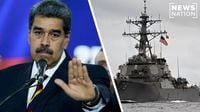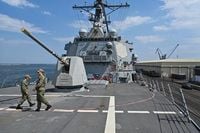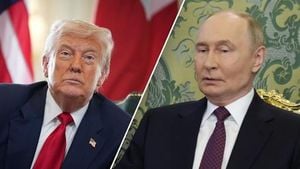In a move that has sent ripples across the Caribbean and beyond, the United States has deployed three Aegis guided-missile destroyers—the USS Gravely, USS Jason Dunham, and USS Sampson—to waters off Venezuela, sparking the most significant military buildup in the region since the 1989 invasion of Panama. The operation, ordered by President Donald Trump, is framed as a robust response to the threats posed by Latin American drug cartels, but it has rapidly escalated tensions with the government of Venezuelan President Nicolás Maduro.
According to Reuters and the Associated Press, the destroyers are expected to arrive off Venezuela between August 19 and 20, 2025, joining a growing U.S. naval presence that already includes the Iwo Jima Amphibious Ready Group, a Marine Expeditionary Unit, P-8 Poseidon reconnaissance aircraft, additional warships, and at least one nuclear-powered attack submarine. In total, about 4,000 sailors and Marines are being deployed, making this the largest U.S. military operation in the southern Caribbean in decades.
The Trump administration has made no secret of its intent. The President has repeatedly blamed Latin American cartels for the flow of fentanyl and other illicit drugs into U.S. communities—problems he argues have contributed to violence in American cities. In February 2025, Trump designated Venezuela’s Tren de Aragua, MS-13 in El Salvador, and six Mexican groups as foreign terrorist organizations, a move usually reserved for entities like al-Qaida or ISIS. The administration contends that the international reach and violent operations of these groups justify the unprecedented classification.
Speaking to AP, a Defense Department official confirmed that the deployment would unfold over several months in support of counter-narcotics efforts. The official, who was not authorized to comment publicly, emphasized the scale and seriousness of the operation. The destroyers, all Arleigh Burke-class warships, bring a formidable array of capabilities to the table. Each is equipped with the Aegis combat system, a cutting-edge integration of radar, computing, and missile technology that enables real-time detection and engagement of multiple threats—be they airborne, surface, or undersea.
The USS Sampson, commissioned in 2007, stands out with its 96-cell vertical launch system, Tomahawk cruise missiles, standard missiles for air defense, and ASROC anti-submarine rockets. Its MH-60R Seahawk helicopters extend its reach far beyond the horizon, providing advanced anti-submarine and surveillance capabilities. The USS Jason Dunham, launched in 2010 and named for a Medal of Honor recipient, boasts advanced electronic warfare suites, towed sonar arrays, and layered missile defenses. The USS Gravely, also commissioned in 2010 and named after Vice Admiral Samuel L. Gravely Jr.—the first African American to command a U.S. Navy warship—offers similar multi-domain versatility, with its own long-range sensors and missile arsenal.
While the U.S. frames the deployment as a counternarcotics mission, the timing and scale have not gone unnoticed in Caracas. President Maduro responded swiftly, ordering the mobilization of more than 4.5 million militia members across Venezuela in what he described as a “special plan” to defend the nation against external and domestic threats. “This week I am going to activate a special plan to guarantee coverage with more than 4.5 million militia members across the entire national territory; militias that are prepared, activated, and armed,” Maduro declared in a televised address on August 18, 2025, as reported by ColombiaOne.
Venezuelan officials have not minced words. Interior Minister Diosdado Cabello, speaking on state television, asserted, “We are also deployed. We are deployed throughout the Caribbean that belongs to us, in our sea, Venezuelan property and territory. That is the truth. The rest are inventions.” Maduro, for his part, reassured the population, “Our seas, our skies, and our lands are defended by us, liberated by us, watched and patrolled by us. No empire is going to come and touch Venezuela’s sacred soil.”
The U.S. has further ratcheted up the pressure by doubling the reward for Maduro’s capture to $50 million, accusing him of being one of the world’s largest narco-traffickers and alleging he works with cartels to flood the U.S. with fentanyl-laced cocaine. Earlier this month, U.S. Attorney General Pam Bondi announced the seizure of $700 million in assets linked to Maduro, intensifying the legal and financial squeeze on the Venezuelan leader. Maduro’s legal troubles in the U.S. are not new: he was indicted in a New York federal court in 2020 on charges of narco-terrorism and conspiracy to import cocaine, with an initial $15 million reward for his arrest.
The Venezuelan government has dismissed the U.S. accusations as baseless and politically motivated. Foreign Minister Yvan Gil, in a statement cited by AP, said, “Washington’s accusing Venezuela of drug trafficking reveals its lack of credibility and the failure of its policies in the region. While Washington threatens, Venezuela steadily advances in peace and sovereignty, demonstrating that true effectiveness against crime is achieved by respecting the independence of its peoples. Every aggressive statement confirms the inability of imperialism to subdue a free and sovereign people.”
Amid these developments, rhetoric on both sides has grown sharper. Last week, Republican Senator Bernie Moreno of Ohio, speaking in Colombia, predicted that Maduro’s government would not survive beyond December of this year, further fueling speculation about Washington’s endgame. The Trump administration has also pressed newly elected Mexican President Claudia Sheinbaum to take a tougher stance against cartels, though Sheinbaum has firmly rejected any suggestion of U.S. military intervention on Mexican soil, citing her country’s sovereignty.
Despite the saber-rattling, most political analysts remain skeptical that an outright military confrontation is imminent. As ColombiaOne notes, the rapid escalation of statements and the deployment of U.S. warships are widely interpreted as a show of force intended to pressure Maduro, rather than a prelude to invasion. However, with thousands of troops and advanced weaponry on both sides of the Caribbean, the risk of miscalculation is palpable—and the margin for error is shrinking.
The situation is further complicated by the legacy of Maduro’s controversial re-election just over a year ago, which was widely condemned as fraudulent by opposition groups and international observers. Trump’s return to the White House has only inflamed the standoff, with each side portraying the other as the real aggressor. An open conflict, analysts warn, could destabilize the entire Caribbean region, with unpredictable human, political, and economic consequences.
For now, the destroyers steam toward Venezuelan waters, militias mobilize, and the world watches—hoping that diplomacy, not firepower, will ultimately prevail.





